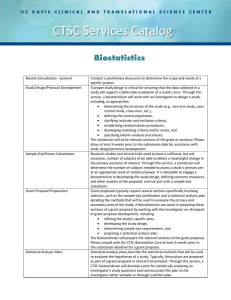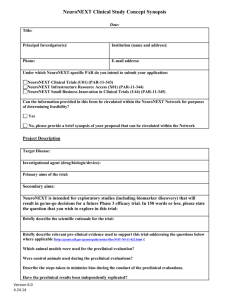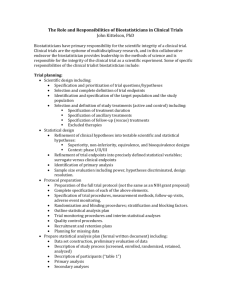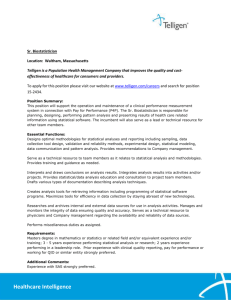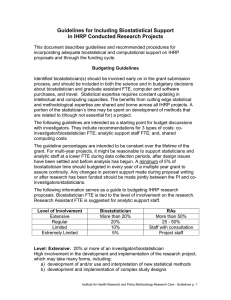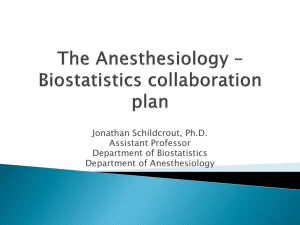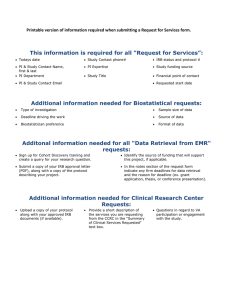University of California Davis School of Medicine
advertisement
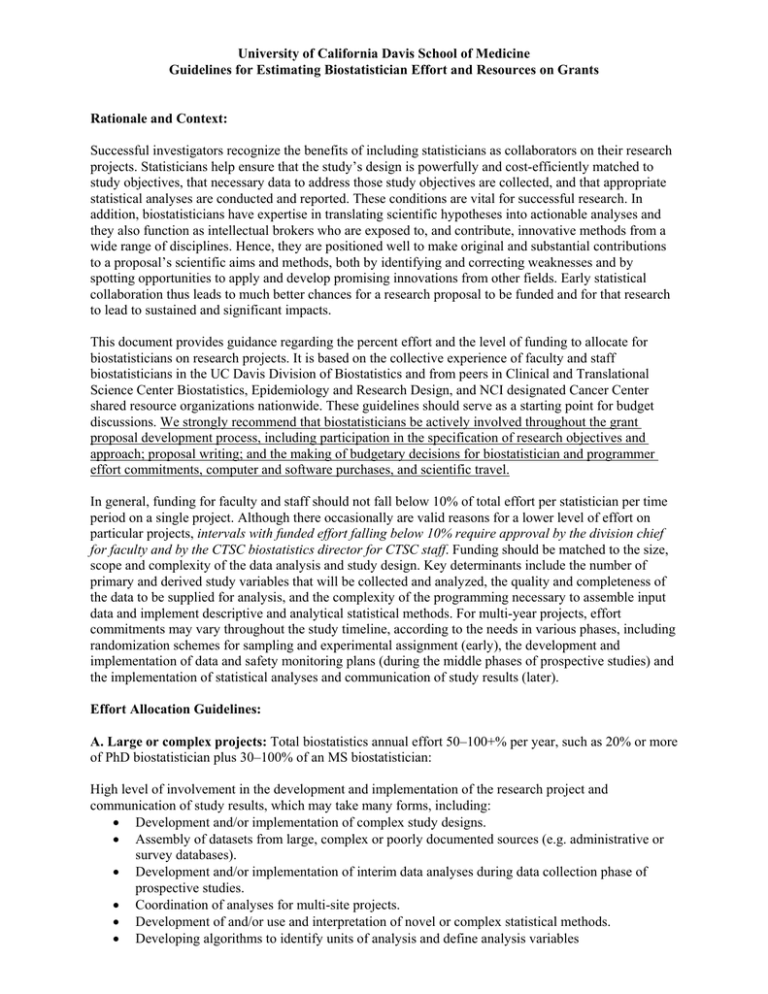
University of California Davis School of Medicine Guidelines for Estimating Biostatistician Effort and Resources on Grants Rationale and Context: Successful investigators recognize the benefits of including statisticians as collaborators on their research projects. Statisticians help ensure that the study’s design is powerfully and cost-efficiently matched to study objectives, that necessary data to address those study objectives are collected, and that appropriate statistical analyses are conducted and reported. These conditions are vital for successful research. In addition, biostatisticians have expertise in translating scientific hypotheses into actionable analyses and they also function as intellectual brokers who are exposed to, and contribute, innovative methods from a wide range of disciplines. Hence, they are positioned well to make original and substantial contributions to a proposal’s scientific aims and methods, both by identifying and correcting weaknesses and by spotting opportunities to apply and develop promising innovations from other fields. Early statistical collaboration thus leads to much better chances for a research proposal to be funded and for that research to lead to sustained and significant impacts. This document provides guidance regarding the percent effort and the level of funding to allocate for biostatisticians on research projects. It is based on the collective experience of faculty and staff biostatisticians in the UC Davis Division of Biostatistics and from peers in Clinical and Translational Science Center Biostatistics, Epidemiology and Research Design, and NCI designated Cancer Center shared resource organizations nationwide. These guidelines should serve as a starting point for budget discussions. We strongly recommend that biostatisticians be actively involved throughout the grant proposal development process, including participation in the specification of research objectives and approach; proposal writing; and the making of budgetary decisions for biostatistician and programmer effort commitments, computer and software purchases, and scientific travel. In general, funding for faculty and staff should not fall below 10% of total effort per statistician per time period on a single project. Although there occasionally are valid reasons for a lower level of effort on particular projects, intervals with funded effort falling below 10% require approval by the division chief for faculty and by the CTSC biostatistics director for CTSC staff. Funding should be matched to the size, scope and complexity of the data analysis and study design. Key determinants include the number of primary and derived study variables that will be collected and analyzed, the quality and completeness of the data to be supplied for analysis, and the complexity of the programming necessary to assemble input data and implement descriptive and analytical statistical methods. For multi-year projects, effort commitments may vary throughout the study timeline, according to the needs in various phases, including randomization schemes for sampling and experimental assignment (early), the development and implementation of data and safety monitoring plans (during the middle phases of prospective studies) and the implementation of statistical analyses and communication of study results (later). Effort Allocation Guidelines: A. Large or complex projects: Total biostatistics annual effort 50–100+% per year, such as 20% or more of PhD biostatistician plus 30–100% of an MS biostatistician: High level of involvement in the development and implementation of the research project and communication of study results, which may take many forms, including: Development and/or implementation of complex study designs. Assembly of datasets from large, complex or poorly documented sources (e.g. administrative or survey databases). Development and/or implementation of interim data analyses during data collection phase of prospective studies. Coordination of analyses for multi-site projects. Development of and/or use and interpretation of novel or complex statistical methods. Developing algorithms to identify units of analysis and define analysis variables Active participation in publications, with opportunity for first authored papers. B. Regular Projects: Total biostatistics annual effort 30–65%, such as 10–15% PhD biostatistician plus 20–50% of an MS biostatistician. This effort profile is suitable for straightforward projects with uncomplicated analyses and includes: Collaboration and involvement of biostatisticians through all phases of the study, including regular meeting attendance. Involvement of biostatisticians in routine study design, implementation, and data collection. Well-documented primary datasets provided for statistical analysis Analyses carried out using off-the-shelf procedures available in statistical software packages. Active participation of biostatisticians in publications, with opportunity for first authored papers. C. Simple Projects: Total biostatistics effort 20–35% per year, such as 5-10% of PhD Biostatistician plus 10-25% of an MS biostatistician. This effort profile is suitable for simple projects requiring minimal PhD biostatistician collaboration and straightforward statistical analyses performed by MS biostatistician (for about one manuscript per year). Ongoing occasional consultations with PI about study issues, such as choice of statistical methods to use. This level of effort is typically too low for a PhD-level biostatistician to carry out analyses or support regular attendance at weekly or biweekly project meetings by the PhD biostatistician. This level of effort commitment and support for the PhD biostatistician is generally not compatible with smooth workflows and readily available consultation support, unless an experienced and capable MS biostatistician is adequately supported on the project as well. D. Limited Scope projects: <10% biostatistician annual effort Occasionally, a limited amount of biostatistician funding may be justified, for example, for assistance planning very small-scale Phase I trials or modest proof-of-concept animal studies, where some statistical analysis will be needed but the scope is limited. Very small projects may budget for biostatistics services using the approved biostatistics recharge rate in place of personnel effort. Please discuss these unique situations with the biostatistician to determine the appropriate effort level and/or use of the recharge rate E. Other Budgetary Considerations: In general, biostatisticians help to develop proposals without compensation, including such aspects as calculation of samples sizes, analysis of preliminary data, and writing of statistical sections of grants, since it is assumed that the major biostatistical effort on the project will be via allocated funded effort post-award. Any changes to the budget in sponsored effort commitment made during proposal writing or after research has been funded must be made jointly between the PI and biostatisticians with adequate lead-time. If funding for biostatistician efforts are reduced due to budget cuts, then the work of the biostatistician must also be reduced, and this requires consultation between the PI and the biostatisticians. Simply reducing sample sizes does not reduce the amount of work to do the analysis! If reductions to effort must be made, it is critical that the PI provide sufficient lead-time (at least 1 month) so that the planned effort can be reoriented to alternative projects. There is a modest level of funding from the CTSC/SOM to support unfunded statistical efforts. In no case is this to be used for a funded project, and the highest priority is for grant development. In general, the time allocated to a specific project in this category will not exceed 10 hours, which means that large, complex projects cannot generally be supported without extramural or departmental funding for the statistical effort. There are some grant mechanisms that do not support funded effort by biostatisticians; this may include some K-awards. In this case, the PI should discuss the proposal with the division chief or CTSC biostatistics director. Sometimes additional resources are required, such as computer hardware, specifically required software, publication costs, and travel to scientific meetings. Most biostatisticians do not have September 2013 2 other funding to cover these resources. Please discuss this in advance, during the budget development phase. E. Other Considerations: Other relevant information and policies is contained in as separate document. This includes the issue of authorship, which according to ICMJE guidelines (http://www.icmje.org/ethical_1author.html) should be based on contribution and not on financial issues. In particular, a biostatistician who both (i) contributed substantially either to study design or to data analysis and interpretation and (ii) drafted or revised the manuscript should generally be presumed to be a co-author and should be asked to give final approval to the version of the article to be published. September 2013 3
